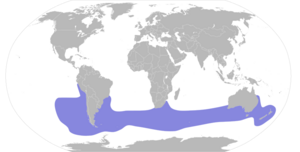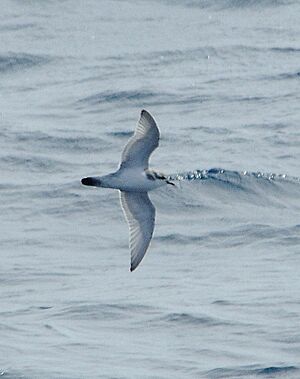Slender-billed prion facts for kids
Quick facts for kids Slender-billed prion |
|
|---|---|
 |
|
| Conservation status | |
| Scientific classification | |
| Genus: |
Pachyptila
|
| Species: |
belcheri
|
 |
|
The slender-billed prion (Pachyptila belcheri), also known as the thin-billed prion, is a type of petrel. Petrels are seabirds that belong to the family Procellariidae. You can find this bird flying over the southern oceans.
Contents
About the Slender-billed Prion
What is a Prion?
Prions are small petrels that are sometimes called whalebirds. They have some special features. For example, their nostrils are on top of their upper bill, and these nasal passages connect to the bill. Their bills are also unique because they are made of 7 to 9 hard plates. The name "prion" comes from a Greek word meaning "saw," which describes the saw-like edges of their bills.
Prions can also make a special stomach oil. This oil is stored in their stomach and is very rich in energy. They use it to feed their chicks and to give them energy during long flights. It can also be used to spray at predators if they feel threatened. Another cool feature is a salt gland above their nose. This gland helps them remove extra salt from their bodies, which is important because they drink a lot of salty ocean water.
How Was This Bird Named?
The slender-billed prion was first officially described in 1912 by an Australian bird expert named Gregory Mathews. He gave it the scientific name Heteroprion belcheri. Today, this prion is grouped with other prions in the genus Pachyptila. This genus name comes from Ancient Greek words meaning "dense" or "thick" and "feather."
The specific name belcheri was chosen to honor Charles Frederic Belcher, an Australian judge and bird enthusiast. He found the first dead specimens of this bird on a beach in Geelong, Australia. The slender-billed prion is considered a single species, meaning there are no different subspecies recognized.
What Does a Slender-billed Prion Look Like?
Like all prions, these birds have a blue-grey color on their upper bodies and are white underneath. They have a dark "M" shape across their back and wingtips. You can see a white line above their eyes and a dark line that goes from below the eye almost to their neck. Their tail is wedge-shaped and grey with a black tip. Their bill is blue-grey, and their feet are a pale blue color.
Where Do Slender-billed Prions Live?
Slender-billed prions spend most of their time flying over the southern oceans. They only come to land when it's time to breed. They build their nests on islands like the Crozet Islands, the Kerguelen Islands, the Falkland Islands, and Noir Island off the coast of southern Chile.
Slender-billed Prion Behavior
What Do They Eat?
Like other prions, the slender-billed prion eats tiny ocean creatures called zooplankton. They have a special bill that helps them filter these small organisms out of the water.
Reproduction and Life Cycle
Slender-billed prions breed every year. The female bird lays one egg. Both parents take turns incubating the egg to keep it warm. They also both care for the young chick until it is old enough to fly on its own.
Conservation Status
The slender-billed prion has a very large area where it lives. Experts estimate that there are about 7,000,000 of these birds. Because their population is so large and widespread, the IUCN (International Union for Conservation of Nature) has classified them as a species of Least Concern. This means they are not currently at risk of disappearing.





